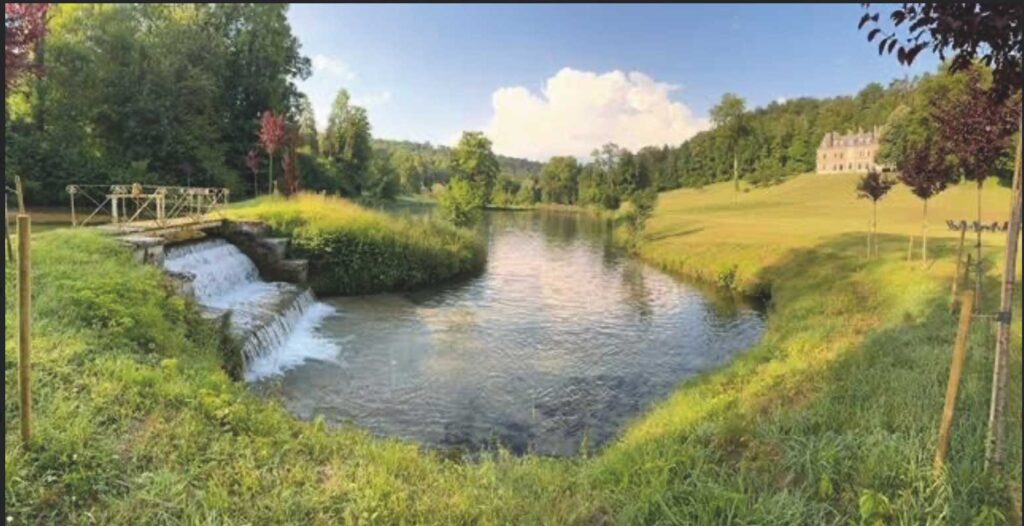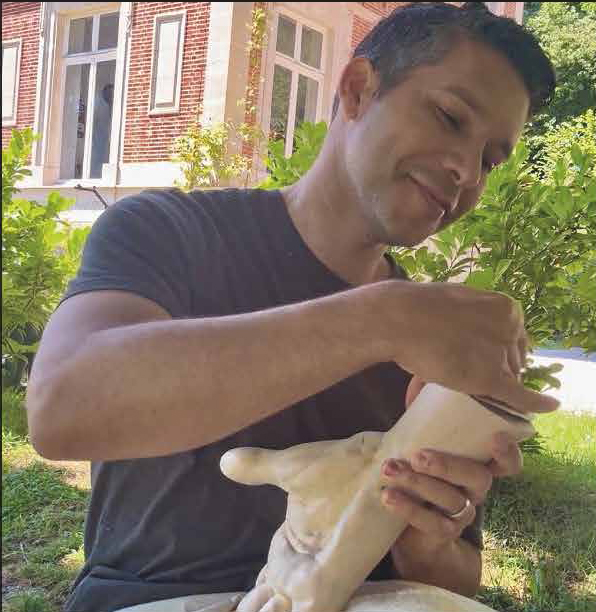Lorenzo Cardim
Resting in the heart of a small village in Champagne, France, Château d’Orquevaux seemed to exist beyond the grasp of time. The stones of the Château held the memories of those who had passed through—Antoine de Saint-Exupéry’s dreams, Denis Diderot’s words—all lingering in the air like the mist that hovered over the valley at dawn. Each morning, I awoke not to the sound of alarms or the demands of the day, but to the soft breath of the French countryside, whispering that there was no need to rush.

The world beyond those ancient walls may have spun in its usual haste, but here, time moved with the rhythm of the land. I would sit with my tools at first light, carving hands and lips from wood as the sun cast its changing shadows across the hills. My hands worked steadily, yet my thoughts drifted, carried by the quiet of the valley. These wooden forms— silent and unmoving—paid tribute to the stories that shaped me, to the connections we build, and to the longing that unites us all. In each finger and palm, I carved echoes of people I had met, those who had crossed seas and borders, carrying within them a quiet hope for belonging and the courage to reach into the unknown.
In the silence of the Château’s gardens, where the mist gave way to the crisp air of midday, I found meaning not in perfection, but in the imperfections of each piece. The unexpected bends in the wood, the small flaws, became part of their stories, much like the unique paths we all take. By evening, as the
hills blazed with the gold of the setting sun, I was reminded that though time passed, it did so with a kind of grace that asked for nothing in return. In those quiet moments, I realized these hands were more than carvings; they celebrated human connection, courage, and the timeless bonds that unite us. At times, I would set the wood aside and turn to textile, weaving stories with fabric and thread in lieu of timber and chisel. Each stitch held the weight of history—stories of immigrants who had crossed the U.S. border, journeys made under foreign skies, and steps taken with trembling hope. I thought of their courage as they left everything familiar behind, often with little more than a handful of belongings and hearts full of dreams. Each piece of fabric seemed to carry the voices, laughter, tears, and unwavering strength of those who had traversed deserts and rivers, faced uncertain fates, and yet, kept going. Though delicate, these stories were unbreakable, much like the spirit of those seeking not just survival, but a place to belong. As I sewed, I reflected on the strength it takes to carry such histories—to stitch together fragments of a life scattered by borders, pieced back into something new, something they could one day call home.
The Château, with its own rich history, became my sanctuary at a time when I yearned for a quieter space to reflect, a place to rekindle the creativity that had first drawn me to my craft. I had spent the last four years deeply immersed in two monumental projects—the reconstruction of Notre Dame de Paris and Buckminster Fuller’s geodesic dome at the Smithsonian American History Museum. Both projects were significant, architecturally and emotionally, and through them, I gained insights into resilience and the beautiful convergence of art and science. These experiences brought me face-to-face with the endurance of human ingenuity and the grace of preservation, lessons I held with quiet reverence.
As these projects concluded, I felt a familiar pull back to the roots of my creative work—not a need to escape, but a call to pause, to explore more deeply, and to understand the path my hands and heart had quietly traveled over the years.
The Chateau was the ideal setting for this introspection. Built in the early 18th century, it held echoes of a past steeped in industrial progress and family legacy. Abel Caroillon du Vandeul, an industrialist, acquired the estate in the 1760s, establishing a metal forge that remained with his family for over a century. Through marriage, the du Vandeul family connected with the philosopher Denis Diderot, preserving the estate through periods of transformation and quiet resilience.
Sadly, history rarely unfolds without moments of turmoil. During World War II, the Château was seized by the Nazis, like so many grand estates across France. Its strategic location and historical significance made it a prime target for occupation. After the war, the property was reclaimed by its original owners, though it had taken on new meaning. Once marked by industry, the Château now stood as a symbol of endurance—a place that had weathered the storms of war and occupation, much like the hands that had built and rebuilt it over centuries.
In 2003, a new chapter began when the Attias family acquired the estate, and with the vision of their son, Ziggy Attias, and his partner, Beulah van Rensburg, transformed it into a haven for artists worldwide. Today, the Château stands as a sanctuary for creative exploration, a place where history and imagination merge, and where the past whispers its lessons to those willing to listen. Artists are free to create within its timeless beauty, to breathe, and to find themselves in stories older than their own. It was in this quiet space, where the echoes of history mingle with the hum of creative pursuits, that I too found myself immersed in a deeper understanding of time and purpose.


As Antoine de Saint-Exupéry once wrote, “It is the time you have wasted for your rose that makes your rose so important.” Like Saint-Exupéry’s rose, the Château offered me the gift of time. Here, I could step away from the structured days of administration, to engage with my art in a thoughtful and profound way. Yet one of the most cherished gifts of my time at the Château was not the work alone, but the presence of others who joined me on this journey. Writers, poets, painters, printmakers, singers, dancers, and the chefs who nourished us each day—all with their own simple, honest arts—filled our hearts and bodies with sustenance. In their company, I was reminded that true creation is not a solitary act, but a symphony of shared silences, conversations, and a mutual search for meaning.
Château d’Orquevaux did not merely shelter us—it spoke to us, taught us. In its stillness, I learned the true value of presence, of allowing oneself to simply be. I came to understand that creation is not born from hurried hands or restless hearts, but from moments of quiet, when we allow ourselves to breathe deeply and listen. And in those breaths, in those pauses, I found that the greatest art is not in the product, but in the act of being fully alive, fully present, fully still.

